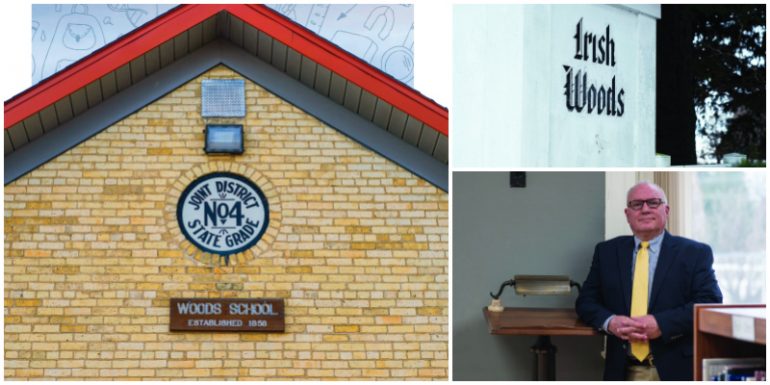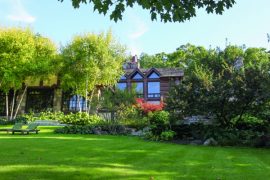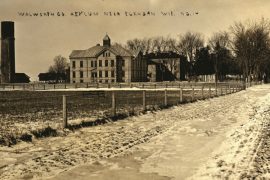By Sarah T. Lahey
In 1858, a few brave voices fought for the Woods School amid political turmoil. The largely Anglo-Saxon and Protestant community in Lake Geneva’s town center wanted little to do with the Irish immigrants living west of town (along today’s Highway 50 at Snake Road) in an area known as the “Irish Woods.” These Celtic and Catholic immigrants kept to themselves, farming the land and struggling to make a living. Faced with discrimination, residents of the Irish Woods petitioned for their own school district in 1857. A year later, they had a one-room, wooden schoolhouse all to themselves — the Woods School.
THE IRISH IN LAKE GENEVA
Although the Village of Geneva (later to be re-named Lake Geneva) was incorporated in 1844, there were few Irish immigrants in the area until the arrival of the first railroad.
In 1853, the Wisconsin Central Railroad Company received a charter to build a railroad from the state line, at Genoa junction, heading northwest through the villages of Geneva, Elkhorn and Whitewater. The goal was to connect Chicago to southeast Wisconsin, but it was a doomed endeavor. The railroad operated in some capacity until 1860, when it was closed permanently due to poor tracks.
Wisconsin Central Railroad, nevertheless, had already hired many Irish immigrants as construction workers. These men brought their families to the Lake Geneva area and soon found themselves out of work. As local historian Patrick Quinn has noted, the Irish worked diligently to build the foundation of this railway, “But when they had finished their endeavor, they were unceremoniously discharged from their jobs and left stranded in Geneva.”
Fortunately, the Irish were not known for giving up. Many of these families, or their near-ancestors, had escaped the Irish Potato Famine of the 1840s — which devastated huge portions of rural Ireland. These were resourceful people, accustomed to a life of hardship and struggle. The rail workers, according to Patrick Quinn, quickly learned that “cheap land was available in a woody area about three miles west of Geneva,” and they used “what was left of their pay” to secure down payments on property. The area became known as the Irish Woods, an enclave in which these immigrants could bind together not merely to survive but also to create a dependable community.
The first priority was church. Residents of the Irish Woods became regular patrons of Lake Geneva’s St. Francis de Sales Catholic Church, which had been established in 1847. In the first decades of operation, the church hosted rectors with names like Brennan, O’Connor, Kenney, McGinnety and Reilly — all suggesting the Irish roots of this Lake Geneva institution. Gravestones in the church cemetery still offer evidence of the many Irish families who called this church home after the railroad brought them to town.
The next priorities were work and school. Some of the Irish found jobs with the Knickerbocker Ice Company during the winter, cutting ice at Lake Como. Others were primarily out of work until the 1870s when two massive changes brought jobs to the area. First, work began on a new railroad connecting Chicago and Lake Geneva — a project that conveniently was completed by the time of the Great Chicago Fire of 1871. As wealthy Chicagoans fled to Lake Geneva, a new smattering of jobs emerged. Suddenly, Irish men and women could find work as maids, cooks, servants, and groundskeepers in the large mansions being built around the lake. The labor crisis was over, and it was time to look after the children.
FOUNDING OF WOODS SCHOOL
Originally known as the “Irish Woods School,” the current Woods School began as a small, wooden structure built on land donated by Lige Marble. Her only stipulation was that the land must always be used for school purposes. Another patron who contributed to the school was the enormously wealthy S. B. Chapin, owner of Flowerside Inn and several farms between Lake Geneva and Lake Como. He built a stone wall alongside the school property to demarcate this new area as specific to the school.
The school went through several physical changes in the 19th century. Marie Cronin, who compiled a detailed history of the school in 1945, notes the original wooden structure was given to Martin Nohelty in 1886 in exchange for a quarter-acre of his land, which abutted school property. Nohelty moved the wooden schoolhouse to his farm for use as a cow barn. The school then erected a one-room brick schoolhouse, which remains part of Woods School to this day (as the library). There are few records of school attendance during this period, but we do know there were 40 students enrolled at Woods School in 1873. The brick schoolhouse, then, housed roughly 40 students who were educated — all day — in a single room.
In the early 20th century, some of the wealthiest residents of Lake Geneva took an interest in Woods School, which still served a predominantly Irish Catholic population. Mrs. S. W. Allerton, for example, became concerned the children had no supervision during the summer. With many adults from the Irish Woods working full-time at summer estates (such as the one owned by Mrs. Allerton, called “Folly”), the kids were running rampant. So, Allerton decided to start a summer program at Woods School in the domestic sciences. She purchased equipment for classes in sewing, cooking, and baking, while arranging for teacher salaries. Rumor has it that Mrs. Allerton even taught some of the classes herself when teachers were absent.
FIGHTING AGAINST STIGMA AND STEREOTYPE
Patrons such as Mrs. Allerton, though, were not necessarily the norm. Irish immigrants in Lake Geneva and elsewhere faced enormous prejudice from the 1840s through the 1920s. It’s hard to imagine, given the general atmosphere of acceptance surrounding Irish Americans today. For the last half-century, Americans of Irish descent have been prominent in politics, business and entertainment. People from all walks of life celebrate St. Patrick’s Day, and many claim Irish ancestry if merely through one relative many generations back. It is surprising, then, to learn about the harsh reality that Irish immigrants faced.
In his groundbreaking book, How the Irish Became White, Noel Ignatiev argues that Irish immigrants — upon arrival in the United States — were treated as an inferior race. The “celts,” as they were called, were mocked in public and sketched as ape-like figures in political cartoons.
The rise of a nativist political party, called the “Know Nothings,” points to the extremity of the situation. The Know Nothings campaigned against the “sin” of Catholicism and fought to block all immigration from Ireland. The Irish of the 1840s came to this country penniless and starving, and soon they found many Americans viewed them as little better than slaves. As Orestes Brownson wrote in 1845, the Yankee “looks down with ineffable contempt upon his Irish brother… for, in his estimation, ‘Paddy’ hardly belongs to the human family.”
When Woods School was founded, one imagines the situation in Lake Geneva was not entirely different from the rest of the country. While the historical record is slim, a single reference in James Simmons’ Annals of Lake Geneva (1897) suggests a sharp discord between the “Yankees” in town and the residents of the Irish Woods — all surrounding the topic of education.
SCHOOL POLITICS: DISTRICT 1 OR 4?
Given the political climate of the 1850s, the start of Woods School was not without some drama. According to the Wisconsin Historical Society, the “center of Irish settlement” was part of Lake Geneva School District #1 as of 1857. The settlers petitioned, at that time, to control their own schools and were briefly granted a separate district. However, according to the society’s report, the residents of Irish Woods voted to rejoin Lake Geneva’s District #1 shortly thereafter. The reason for such flip-flopping is unclear, but the Woods School remained part of District #1 for the next 60 years.
In 1929, a dispute over whether or not to construct a new Lake Geneva high school prompted Woods School parents to push for independence once again. They succeeded and emerged as Joint District #4, which included Linn Township as well as Woods School. This was a stable arrangement for the next 30 years, until district changes across the state of Wisconsin rocked the boat once more.
In 1965, the Walworth County School Committee sent word that it was dissolving District #4 and attaching it to District #1. Parents in the Woods School community immediately responded, organizing their efforts to bring the issue to referendum. They prevailed — by one vote — and Woods School remained an independent district. There were further votes on this issue in 1966 and 1968, but Woods School retained its independence.
Current principal Jeffrey Klaisner commented that the 1960s were an era of radical change for districts across the state, as Wisconsin moved to consolidate over 1,000 districts into a mere 432. There were only 10 areas that resisted consolidation, and this included Woods School. Klaisner states there are no current plans for feeder districts of Badger High School to consolidate because the schools “value their independence and the local control this arrangement provides.”
THE IRISH WOODS SCHOOL TODAY
While the student body is no longer predominantly Irish, Woods School retains its unique character and continues to grow. In 2001, the school purchased several acres of land to expand their athletic fields and playground, to the great enjoyment of the students. In 2017-2018, the school underwent massive renovations to add a new gymnasium, science lab and additional classrooms. At a cost of $5.4 million, this project was approved in referendum and was several years in the making. Students attend Woods School via open enrollment, and these new facilities help to keep the school competitive.
That being said, families in the area are mostly drawn to the school’s reputation for academic excellence. According to the Wisconsin Department of Public Instruction, the Woods School “significantly exceeds expectations” in all categories, with a report card score of 85.6 in 2017. The Woods School flourishes in the classroom, which has always been the focus of this historic grade school.
“We honor the history of Woods School every day we are in session,” says Principal Klaisner. “Students are frequently reminded of our traditions and have the opportunity to learn in the oldest rooms in the building at least once a week.” These rooms now comprise the library, which was specifically designed as a historical space. Klaisner adds, “There is a special atmosphere when you go to learn in a room so filled with memories of our past. The original slate boards have been preserved and are being used inside and just outside of the library.”
At 161 years old, Woods School remains one of the oldest continually operating primary schools in the state of Wisconsin. The help of wealthy patrons such as S. B. Chapin and Agnes Allerton contributed to that legacy; however, it was the effort of the Irish community that first made the school a success. It survives today — including a one-room brick structure from 1886 — as a modern and dynamic public school with the ‘luck of the Irish’ on its side.





